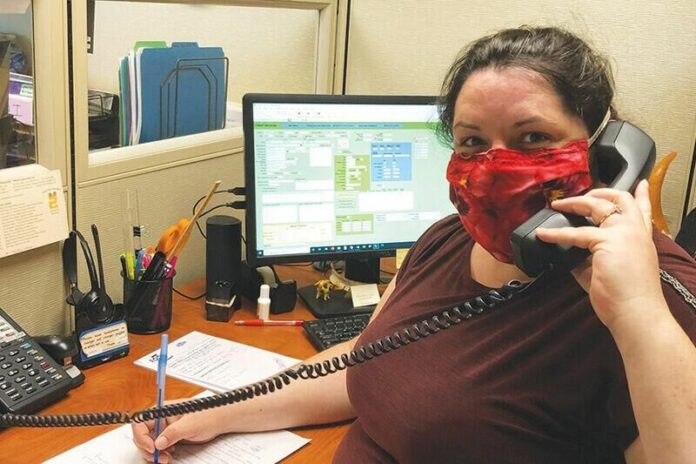Word from the Sonoma County Department of Health Services (DHS) arrived Feb. 26 that an asymptomatic passenger of the Diamond Princess cruise ship tested positive for COVID-19 and was being treated at a hospital in Sonoma County, transferred from Travis Air Force Base in Solano County.
The DHS announced on March 2 that a local resident who recently traveled abroad was presumed to be infected with the death-dealing novel coronavirus puzzling experts around the world. California had only 43 confirmed cases among the 300 tested at the time.
Sonoma County declared both a local public health emergency and a general local emergency regarding COVID-19, waiting for test kits and starting up its Emergency Operations Center to meet the hour of need that consumed the rest of the year.
School shutdowns began after the county health department officially recommended schools suspend in-person education on March 14.
March 18 goes down in local history as the day Sonoma County Public Health Officer Dr. Sundari Mase issued the county’s first shelter-in-place order, intended to limit all but the most essential travel and activity for three weeks until April 7.
The order mandated all residents to shelter at home and stay at least six feet away from others when outside or in shared spaces.
Thus began the ongoing debate over what operations are truly essential and why, as the county, the country and the entire world fought for the literal survival of immune-compromised populations and to survive the economic crater.
The county updated its case numbers and released demographic data March 27, revealing a total of 54 cases, marking 40 as active, 13 recovered and one dead. Thirteen of the 54 infected people landed in the hospital during their illness.
5th District Supervisor Lynda Hopkins reported that day that 94% of the 1,214 tests conducted by the public came up negative and 4% were positive. West county’s Sebastopol and Guerneville had nine confirmed cases of COVID-19, according to Sonoma West Times & News.
On March 31, Mase extended the shelter-in-place order to May 3. The county rose to 85 total cases, 71 active and two marking the first cases in children 17 years-old and younger in the area. Mase said the county prioritized essential workers like health care workers, first responders, and those in jails, long-term care centers and some other congregate environments for testing.
The county started working with service providers, nonprofits and community organizations to address the food insecurity, mental health struggles, homelessness and massive unemployment among the population by the end of March.
By April, the Imperial College of London’s models showed the county’s shelter-in-place order working to flatten the curve, lower deaths of people over 65 years-old and push back the surge now anticipated in two months, around the end of May.
Sonoma West Times & News reported the surge would claim 1,500 hospital beds instead of the 9,000 beds predicted by county public health officer Mase to overwhelm local resources if the county didn’t call for a shelter-in-place order back when the county had around four cases and one fatality.
Mitigation measures would be key to preventing or dulling a second wave of cases after the shelter-in-place order lifts, Mase said, estimating a vaccine would become available at least one year from then.
People coped in strange, beautiful and boring ways hanging around at home and discouraged from interacting with others outside their households. There was Netflix. There was also a Facebook group called, “Go Outside and Howl at 8 p.m.” and residents of Sebastopol and elsewhere in the state …did that, in honor of health care workers, grocery checkers and others on the frontline.
The Sebastopol Seed Bank gave out 1,800 free packs of seeds to enthusiastic gardeners staying home in spring and the town experienced a spike in quarantine block parties, seeking connection across social distance, Sonoma West Times & News reported in April. Meanwhile, local herbalists and distillers sold and donated their own hand sanitizers.
The national debate over whether masks should be required or were effective in preventing the spread of the virus was all too alive then, from the White House to squabbles breaking out in the local grocery store.
A lot was still unknown. “Can it spread on the wind? Can it be spread on ATM machines and money? Can it be spread on furniture, clothing, railings, etc.? Answers to these and other questions are yet to be fully studied, but I would assume the answer is ‘yes.’ At least presume so for your own protection,” said Dr. Jeff Hergenrather, a former emergency room doctor, said in April.
Quinn Roncarati, a textile artist in Monte Rio, organized at least 1,000 volunteers to sew cloth masks for health care workers through her “North Bay Sewists Unite” Facebook group, donating over 1,000 masks to hospitals and senior centers that requested them, she said.
Schools prepared to continue distance-learning until the end of the year, navigating varying access to technology and mental strain among youth from losing structure, social interaction and rites of passage like traditional graduation ceremonies.
In May, the “Sebastomask” program doubled in size after Sebastopol City Councilmember Sarah Glade Gurney raised funds for 500 additional masks for its vulnerable communities, like high-density building tenants, seniors and formerly homeless residents of Park Village.
Sebastopol also installed hand-washing stations downtown, increased website accessibility for its virtual city council meetings, and informed residents their water, power and trash service would not be cut off by the city, PG&E, nor Recology due to nonpayment.
Sonoma County Sheriff Mark Essick said his department would not enforce the county’s shelter-in-place order as of June 1. Sebastopol Police Chief Greg DeVore said the local department would continue to use a “three-stage approach. First, education. Second, warnings coupled with education. Third, and only if necessary, enforcement.”
At the time, 100,000 people had died from COVID-19 in the U.S. and five in Sonoma County. The county delivered a joint statement with the Sheriff’s Office June 2 that the two would cooperate.
COVID-19 was indiscriminately contagious, but existing inequity in living and working conditions led to disproportionate numbers of Latinx residents contracting the virus.
Daily Acts collaborated with the Botanical Bus Bilingual Mobile Herb Clinic to give more than 300 garden kits to Latinx locals and others, emphasizing culturally relevant and familiar plants like epazote, according to Connor DeVane, Daily Acts programs coordinator and Forestville resident.
On June 18, Mase declared a large-scale reopening of businesses that opened the doors for movie theaters, museums, and nail salons and allowed hotels, rentals and campgrounds to host recreational travelers, following an earlier order that let in-person faith services, indoor retail and dining and other operations to reopen, though masks and social distancing were mandatory.
The numbers stood that day at 807 total positive cases, 377 of which were active, 422 recovered, with four deaths in the county, Sonoma West Times & News reported.
However, Sonoma County landed on the state watchlist on July 13 for stronger restrictions and it appeared the county wouldn’t achieve compliance with state standards by Aug. 2, when the state would reassess the restrictions.
Aside from the watchlist, Governor Newsom also announced a new shutdown July 13 that ordered all counties to close dine-in restaurant service, zoos, museums, movie theaters, indoor and outdoor bars and more due to a statewide surge in cases.
Sonoma West Times & News reported July 30 that the county’s virus hospitalizations were too high for the state and for the previous two weeks, the case rate was 151.9 cases per 100,000 when the state required 100 cases or less per 100,000. The county had 1,280 active cases and 31 deaths out of a total 2,748 cases thus far, running low on hospital beds.
The Latinx community made up 69% of the total confirmed cases compared to white residents comprising 24% of infections. West County residents made up 3% of the infected population.
Come August, Sonoma County was still stuck on the watchlist, with 70 total deaths. COVID-19 infections leapt to 4,863 total cases, 2,197 active and 2,596 recovered, county data reported. Public Health Officer Mase cautioned evacuees of the Walbridge Fire to adhere to COVID-19 mitigation measures wherever they found shelter, anticipating a related spike.
Hair salons, barber shops and malls were allowed to reopen with mitigation measures in the county at the very end of August, after Gov. Newsom introduced the “Blueprint for a Safer Economy” framework to replace the state watchlist.
The framework ranked counties into multi-colored tiers depending on their COVID-19 statistics. Sonoma County classified for placement in the purple tier for widespread transmission, the lowest tier with the most restrictions.
That fall, laptops whirred as schools began another semester of distance-learning, since the purple tier prohibits in-person education.
In October, the Sebastopol City Council approved its 2020-2021 budget and decided to start tapping its reserves, projecting a 20% loss of revenue, or around $2.2 million, according to reporting by Laura Hagar Rush of Townsy Media. Sebastopol Budget Director Ana Kwong found dramatic decreases in three of the city’s four primary streams of revenue across the pandemic, which were sales taxes, hotel taxes and user charges.
The county declared on Dec. 10 that it would adopt the California Department of Public Health’s regional stay-at-home order alongside six other Bay Area counties and one city ahead of the mandatory that would come a week later.
The order so far lasts until Jan. 9, 2021 and requires locals to leave home only for the essentials, like work, shopping, medical appointments and outdoor recreation. “All sectors other than retail and essential operations must be closed,” Sonoma West Times & News reported.
Mase reported in a virtual conference on Dec. 14 that Sonoma County would receive its first shipment of the Pfizer COVID-19 vaccine on Dec. 16.
Five boxes with 975 doses were delivered Dec. 16, three headed to Memorial Hospital, Sutter Hospital, and Kaiser Hospital and two reserved by the health department.
Because these hospitals have the capacity to store the vaccines at the required -80 degrees Celsius, they were charged with delivering vaccines to the smaller hospitals, Healdsburg District Hospital, Petaluma Valley Hospital and Sonoma Valley Hospital.
Sonoma West Times & News reported the county anticipated 5,800 doses of the Moderna vaccine following FDA approval in December.









